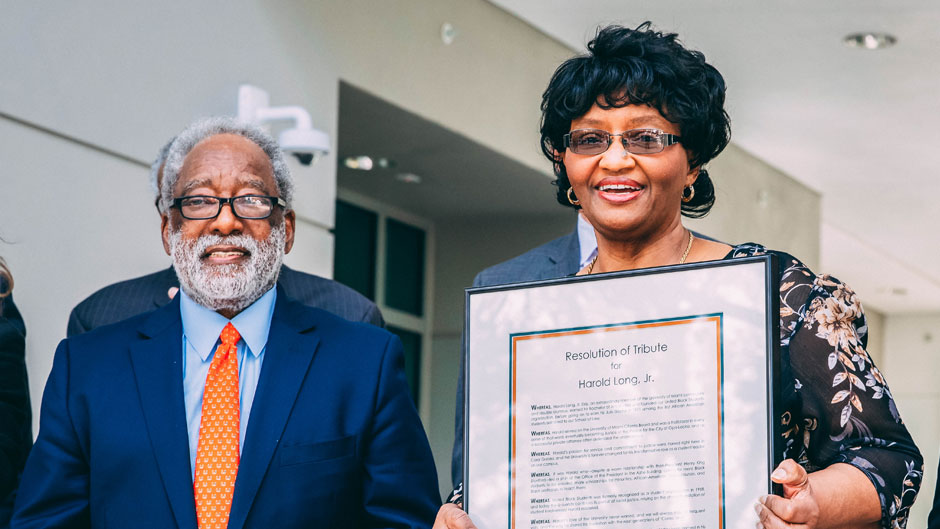Harold Long Jr. and H.T. Smith never needed a covenant sealed with signatures. All it took was a handshake.
And with that symbolic gesture, the two African American attorneys—one, the son of longtime educators; the other, a Vietnam veteran who grew up in his grandmother’s shotgun shack on an Overtown street nicknamed “Bucket Blood”—formed and operated what became the first Black law firm to locate its office in downtown Miami.
Friday, on the University of Miami Coral Gables Campus where they both earned law degrees, the two longtime friends were reunited in name when the institution dedicated a building in their honor.
The Harold Long Jr. and H.T. Smith Student Services Building marks a milestone for the University, becoming the first structure in the school’s history to be named after accomplished Black alumni.
“Universities have a crucial role to play in modeling racial justice,” said President Julio Frenk, noting an initiative launched two years ago that has helped the institution achieve greater diversity, equity, and inclusion across its three campuses. “We remain committed to creating a more just society, and the naming of the Student Services Building is another example of our efforts.”
“Bringing this historic occasion to life took the work of many people,” said Laurie Silvers, chair of the Board of Trustees. She recognized key members of Frenk’s cabinet, including Jeffrey L. Duerk, executive vice president for academic affairs and provost; Patricia A. Whitely, senior vice president for student affairs; Don Spivey, distinguished professor of history and advisor to the president on racial justice; and Jacqueline A. Travisano, executive vice president for business and finance and chief operating officer.
As an undergraduate at the University during the 1960s, Long blazed new trails. He started the United Black Students organization and led a sit-in inside then-President Henry King Stanford’s office, demanding that the institution enroll more Black students, increase the number of scholarships for underrepresented students, create a curriculum focusing on African American history, and hire Black professors to teach those courses.
He graduated from the School of Law in 1971, becoming one of the first Black students to do so, then went on to a distinguished career as a barrister, which included serving as Justice of the Peace for the City of Opa-Locka and defending the underserved as a private attorney.
Long passed away last year at the age of 73.
“He would have been in tears if he were here today to witness this moment,” Long’s widow, Leslie Long, said prior to Friday’s dedication. “He loved the U, and the older he became, he fell in love with it even more. He sacrificed and always fought for what he believed in, even if it would have cost him his life.”
Smith, a longtime University trustee, recalled his former law partner as being “tremendously humble.” The two had practiced law together for a decade, and Smith had always known that Long, as a University student, had led a sit-in in Stanford’s office. But it wasn’t until Smith saw an old newspaper photo of Long in jail that he learned that his colleague, like the civil rights demonstrators of the ’60s, was so passionate about his cause that he was willing to be arrested for it.
“I said, ‘Harold, you never told me that you got arrested for protesting.’ Harold looked at me and said, ‘It never came up.’ That’s how humble he was,” Smith noted.
Starting in the mid-1970s, Long and Smith P.A. rented office space out of One Biscayne Tower in downtown Miami, sometimes representing clients who, unable to afford an attorney, would pay for legal fees by rendering a service of their own. One woman, for example, was an accomplished cook and prepared for them a Bahamian meal of peas and rice and conch fritters, Smith acknowledged.
Their partnership was built on trust.
“We went into practice together on a handshake,” Smith said. “We were so locked into each other’s philosophy of the practice of law and community service and our connection to the University that we trusted each other enough to not need a contract.”
Before the two forged a partnership, Smith became a trailblazer in his own right, serving as Miami-Dade County’s first Black assistant public defender and then as the county’s first Black assistant county attorney.
Smith served more than a year in Vietnam, coming home to Miami in 1970 with a dream of enrolling in the University of Miami’s law school and becoming a lawyer who would defend the rights of the weak and the marginalized. But he faced two obstacles: classes would be starting in just two weeks and he hadn’t even taken the Law School Admission Test (LSAT).
Determined to start classes that semester, Smith drove to the Coral Gables Campus and, without an appointment, met with the law school’s dean, telling him that the LSAT was not administered to soldiers who were fighting and dying in Southeast Asia. “I’m going to be in law school this semester—in the first class, in the first row, in the first seat. That is what I gotta do,” Smith told the dean.
Impressed, the dean worked out an arrangement. He would admit Smith under one condition—that he pass the LSAT the next time the test was given. And Smith did.
Now, Smith’s name appears on the façade of a three-story, 30,000-square foot University building erected to serve students.
The Student Services Building, which opened two years ago and recently achieved LEED Gold certification for its sustainable features, is a one-stop shop for students providing services that include housing registration, financial aid, and academic counseling under one roof.
“My name going up on that building is an incredible honor,” Smith said. “And having it appear with my only law partner, Harold Long, is like hitting the lottery—a million to one.”

